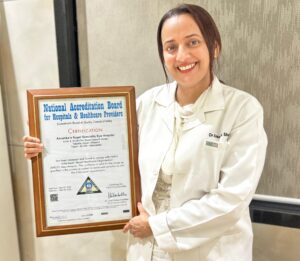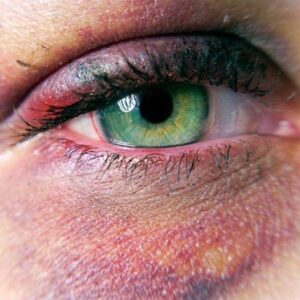
Anushka Super Speciality Eye Hospital
Call: 90044 44422 / 99213 44422 | Timings : 8.30 a.m to 5.30 p.m (Mon-Sat) | Add: Shri Swami Samarth Soc, Kaneri Dhamankar Naka, Bhiwandi




Accredited for Quality Care
Understanding Cystoid Macular Edema (CME): Causes, Symptoms, and Treatment
anushka
11 November 2025
By Dr. Anushka’s Super Speciality Eye Hospital, Bhiwandi — NABH & HOTA Certified
At Dr. Anushka’s Super Speciality Eye Hospital, Bhiwandi, our retina specialists often come across patients who complain of blurred or distorted central vision even after successful cataract surgery or in diabetic eye disease. One of the most common causes behind this complaint is Cystoid Macular Edema (CME) — a condition that affects the central part of the retina called the macula, responsible for sharp and detailed vision.
What is Cystoid Macular Edema (CME)?
Cystoid Macular Edema is a swelling of the macula caused by the accumulation of fluid in small cyst-like spaces within the retina. This swelling leads to distortion or blurring of central vision, making it difficult to read, recognize faces, or perform tasks requiring fine focus.
The macula is a small, but crucial, part of the retina that helps us see clear details. When it becomes swollen, even slightly, visual quality is significantly reduced.
Why Does CME Occur?
CME can develop due to several eye conditions or procedures. The most common causes include:
1. Post-Cataract Surgery (Irvine–Gass Syndrome)
CME may occur weeks after cataract surgery due to inflammation or fluid leakage in retinal blood vessels.
2. Diabetic Retinopathy
Chronic high blood sugar can damage the retinal vessels, leading to fluid leakage and macular swelling.
3. Retinal Vein Occlusion
Blockage in the retinal veins can increase pressure and cause fluid to seep into the macula.
4. Uveitis
Inflammation inside the eye can disrupt the blood-retinal barrier, leading to CME.
5. Use of Certain Medications
Drugs such as prostaglandin analogs used for glaucoma treatment have been linked to CME in susceptible eyes.
Common Symptoms of CME
Patients with CME usually experience:
- Blurring or distortion in central vision
- Decreased visual sharpness (especially for near tasks)
- Difficulty in reading or recognizing faces
- Colors appearing faded or dull
- Metamorphopsia – straight lines appearing wavy or bent
In many cases, the condition affects both eyes, but sometimes only one eye may show symptoms.
Diagnosis: How is CME Detected?
At Dr. Anushka’s Super Speciality Eye Hospital, we use advanced diagnostic tools to detect CME at an early stage:
🔹 Optical Coherence Tomography (OCT)
This non-invasive imaging test produces a detailed cross-section of the retina, helping us visualize the cystoid spaces and measure the thickness of the macula accurately.
🔹 Fundus Fluorescein Angiography (FFA)
A special dye is injected into a vein, and photographs of the retina are taken to identify leaking blood vessels causing the edema.
🔹 Visual Acuity and Amsler Grid Testing
These help evaluate the extent of vision loss and central vision distortion.
Treatment Options for CME
The treatment of CME depends on its underlying cause and severity. At our hospital, retina specialists follow a personalized treatment approach, which may include:
1. Topical Medications
- Anti-inflammatory eye drops (NSAIDs and corticosteroids) are commonly prescribed after cataract surgery to reduce swelling.
- Combined therapy is often more effective than using a single drop.
2. Intravitreal Injections
- Anti-VEGF injections (like Ranibizumab, Aflibercept, Bevacizumab) reduce abnormal leakage from retinal vessels.
- Steroid injections or implants (Ozurdex, Triamcinolone) are also used to control inflammation and fluid accumulation.
3. Systemic Treatment
In uveitic CME or diabetic macular edema, oral steroids, immunosuppressants, or blood sugar control may be necessary.
4. Laser Photocoagulation
Used in specific retinal conditions like diabetic retinopathy or vein occlusion to seal leaking vessels.
5. Surgical Management
In chronic or recurrent cases, vitrectomy surgery may be performed to remove inflammatory mediators and improve retinal health.
Recovery and Follow-Up
Recovery from CME depends on early detection and proper management.
Most patients notice visual improvement within 4 to 8 weeks after treatment.
Regular follow-ups are crucial to ensure the swelling has resolved and to prevent recurrence.
At our hospital, patients receive structured OCT monitoring and medication reviews until the macula returns to normal thickness.
Preventive Measures and Eye Care Tips
While CME cannot always be prevented, these steps can reduce your risk:
- Maintain good control of diabetes and blood pressure.
- Follow all post-operative instructions after cataract or retinal surgery.
- Use prescribed drops regularly and avoid self-medication.
- Get regular eye check-ups, especially if you are diabetic or have had eye surgery.
- Eat an antioxidant-rich diet containing green vegetables, omega-3 fatty acids, and fruits like oranges and berries to support retinal health.
Why Choose Dr. Anushka’s Super Speciality Eye Hospital, Bhiwandi?
- NABH Accredited & HOTA Licensed Eye Hospital
- First in Bhiwandi to perform advanced corneal transplants and robotic cataract surgeries
- Comprehensive Retina Department with state-of-the-art OCT, FFA, and Laser Technology
- Led by Dr. Anushka Sharma, renowned eye surgeon with extensive experience in managing retinal diseases
At Dr. Anushka’s Super Speciality Eye Hospital, our goal is to restore and preserve vision with precision, compassion, and advanced technology.
Takeaway
Cystoid Macular Edema is a treatable cause of central vision loss. With early diagnosis and modern treatment, most patients can regain good vision and return to normal activities.
If you notice blurred or distorted vision after eye surgery or have diabetes, schedule a retina evaluation today.
Final Message:
Dr. Anushka’s Super Speciality Eye Hospital, Bhiwandi
Your Vision, Our Mission — Advanced Eye Care You Can Trust.
Recent Posts


